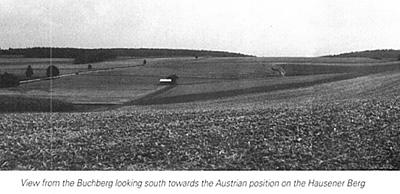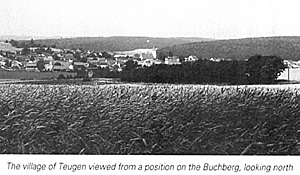 On the evening of the 18 April, Davout gathered his superb team of
divisional commanders and explained the march routes he intended the troops
to take. The supply wagons would use the one good road beside the Danube
leading from Ratisbon to Abensberg. To avoid congestion and to protect the
wagons as they trundled through the vulnerable defile at Saal, three combat
columns would move over the poorer roads while Saint-Sulpice's 3,200 heavy
cavalry covered the main road as well as helping out in the centre. Morand's
and Saint-Hilaire's divisions (21,500 infantry), would march from Ober-Isling
through Hohengebraching, Seedorf, Peising, Teugen, and on to Abensberg.
Gudin and Friant, with 20,000 would begin at Burgweinting and march through
Hinkofen, Wellohe, Saalhaupt, Hausen and then Abensberg. Montbrun's 2,900
cavalry and two battalions of the 7 Legere from Gudin would cover the left
flank from Dinzling to Langquaid, Bachel and again on to Abensberg. Starting
at 5 a.m., this would be a very delicate operation - a flank march across the
front of a large enemy whose whereabouts were unknown.
On the evening of the 18 April, Davout gathered his superb team of
divisional commanders and explained the march routes he intended the troops
to take. The supply wagons would use the one good road beside the Danube
leading from Ratisbon to Abensberg. To avoid congestion and to protect the
wagons as they trundled through the vulnerable defile at Saal, three combat
columns would move over the poorer roads while Saint-Sulpice's 3,200 heavy
cavalry covered the main road as well as helping out in the centre. Morand's
and Saint-Hilaire's divisions (21,500 infantry), would march from Ober-Isling
through Hohengebraching, Seedorf, Peising, Teugen, and on to Abensberg.
Gudin and Friant, with 20,000 would begin at Burgweinting and march through
Hinkofen, Wellohe, Saalhaupt, Hausen and then Abensberg. Montbrun's 2,900
cavalry and two battalions of the 7 Legere from Gudin would cover the left
flank from Dinzling to Langquaid, Bachel and again on to Abensberg. Starting
at 5 a.m., this would be a very delicate operation - a flank march across the
front of a large enemy whose whereabouts were unknown.
Charles had issued orders at 10 a.m. on the 18 from Pfafenhausen for an attack on Davout. He hoped to force him north against Kollowrath and the Danube. He was unaware of the exact position or plans of the Marshal, but believed that he had a fine chance of catching him. As the majority of the Austrian force continued its march on the Upper Gross Laber River during the day, Charles assessed the situation. That evening, the Archduke issued orders on the assumption that Davout was moving up the Danube to Abbach, aimed at concentrating his forces on the Schambach hills. FML (Feldmarshall- Leutnant) Rosenberg's 4th Korps and FML Hohenzollern's 3rd Korps would march to that area while GdK Johannes Lichtenstein's Ist Reserve Korps would remain between Rohr and Bachel. Archduke Louis' 5th Korps would close on the enemy around the Abens and possibly join GIM Thierry, detached from 3rd Korps to watch Biburg, for an assault on Abensberg.
At 3.30 a.m. on the 19, FML Vukassovich at Bachel sent two vital pieces of information that would lead to a change of plan. The first was an intercepted letter from Marshal Lefebvre which had been penned at 4 a.m. on the 18 at Neustadt. This promised Davout his best support if attacked, by challenging the Austrian left as it marched on Ratisbon, with his Bavarians. The second was information on the French dispositions at Ratisbon and on the Bavarians south-west of Neustadt. Charles received these at 5 a.m. and issued new orders at around 7 a.m. from Rohr. He decided to seek battle with Davout who he knew had had actually held his positions on the 18. It was thought likely that he would continue to do so, but the fear was that he might break out in any direction. The situation was unclear, and there were suspicions that the Lefebvre letter was a ruse to draw Charles towards the Abens and away from Ratisbon. The sensible course of action was considered to be an advance on a broad front with a view to engaging Davout as far a possible from Lefebvre.
From right to left, the Austrians were deployed as follows: The first column under Johannes Lichtenstein contained the 1st Reserve Korps cavalry and FML Lindenau's division from 5th Korps, a total of 8,800 infantry, 4,100 heavy cavalry and 40 guns. It was to move on Ratisbon through Langquaid, Schierling, Thalmassing and Gebelkofen. It would pick up Vecsey's brigade of 5,200 infantry, 900 cavalry and 6 guns at Eckmuhl.
 The second column, accompanied by Charles, consisted of Rosenberg's 4th Korps and the
twelve Grenadier battalions of 1st Reserve Korps, a total of 27,000 infantry, 2,200 cavalry and 72 guns. This was the main attacking column and would march from Rohr through Langquaid and Dinzling to Weillohe.
The second column, accompanied by Charles, consisted of Rosenberg's 4th Korps and the
twelve Grenadier battalions of 1st Reserve Korps, a total of 27,000 infantry, 2,200 cavalry and 72 guns. This was the main attacking column and would march from Rohr through Langquaid and Dinzling to Weillohe.
The third column consisted of Hohenzollern's 3rd Korps. The main body would move from Rohr trough Bachel, Grossmuss, Hausen and Teugen, leaving detachments along the way and dividing in an advance on Peising and Abbach. One of the main detachments would be Thierry and the 4th (Levenehr) Dragoons (5,150 infantry, 725 cavalry and 7 guns after 3 heavy pieces became stuck) in the hills around Abensberg and Biburg. They were intended as flank cover and to connect with Louis' 5th Korps. GM Pfanzelter with 1,200 infantry and hussars, would link Thierry with the main body. Part of the reserve artillery was left behind. This left Hohenzollern with 16,420 infantry, 780 cavalry and 54 guns to protect Rosenberg's left.
Louis' 5th Korps (less Lindenau's division), Hiller's 6th Korps, and elements of FML Kienmayer's 2nd Reserve Korps, were to move up on the south- east and to occupy the enemy on the Abens. The main attack columns would meanwhile be marching on a 15 km front across rolling, thickly wooded country where mutual support would prove difficult. Charles would have to rely on the initiative and skill of his subordinates as the Austrian fist became probing fingers.
Hohenzollern marched from Rohr towards Bachel at around 7.30 a.m. Thierry had already set off at 6 a.m. Hohenzollern reported to Charles that he had heard artillery near the Abens, confirming the authenticity of Lefebvre's letter. He had detached Pfanzelter with the 1st battalion of the Peterwardeiner Grenzers, a division of the 3rd (Archduke Ferdinand) Hussars and half of a 3 pounder brigade battery at Bachel to link with Thierry as the main body left the road and took the bad track to Grossmuss. He planned to send a column consisting of FML Lusignan and the advance guard through Teugen and Eiglstetten to Peising. Most of the reserve artillery - two batteries of 12 pounders and one of 6 pounders - was still far behind.
Thierry arrived on the heights near Abensberg and observed the formation of Bavarian road columns apparently heading for Ratisbon. He decided to intervene and sent a small combined force forward at 11 a.m., under the impression that the Bavarians had only cavalry scouts to meet him. He had not sighted the rest of the enemy and thus a tough fight developed. Lefebvre gradually forced the Austrians back and Thierry retired on Biburg and Rohr at 4 p.m. as a brigade from Louis arrived, too late to assist. A wedge had thus been driven between Louis and Hohenzollern. The French would be able to use the road from Saal in peace, as well as restore communications with Davout.
More Battle of Teugen-Hausen 19 April 1809
- Introduction and Background
Preparation for Battle
The Battle of Teugen-Hausen
Order of Battle
The Wargame
Back to Age of Napoleon 19 Table of Contents
Back to Age of Napoleon List of Issues
Back to MagWeb Master List of Magazines
© Copyright 1996 by Partizan Press.
This article appears in MagWeb (Magazine Web) on the Internet World Wide Web.
Other military history articles and gaming articles are available at http://www.magweb.com